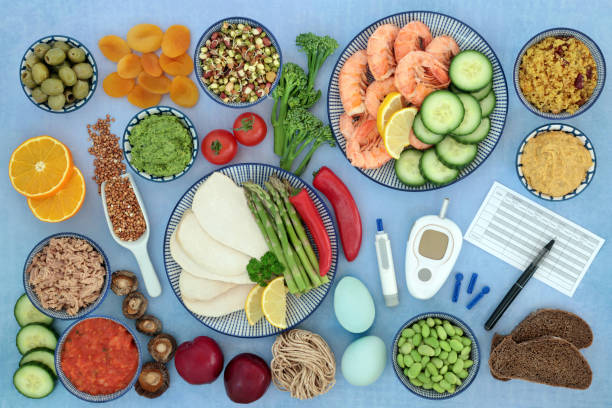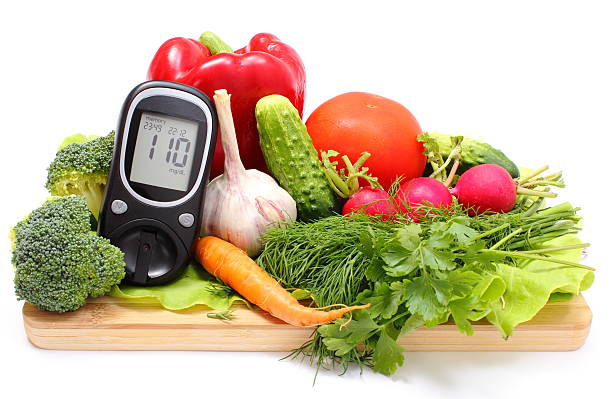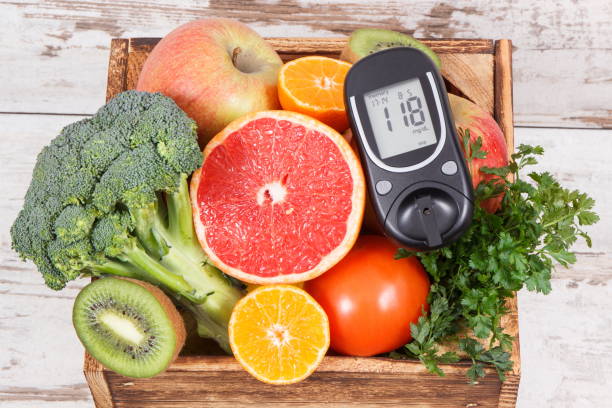Keeping your blood sugar steady doesn’t have to be hard. Small choices add up, and even simple swaps can make a big difference. The foods you pick, and how you pair them, can help you avoid energy crashes, sharp cravings, and mid-day fatigue. When your blood sugar stays balanced, you’ll feel more focused, keep a steady mood, and have lasting energy for work, exercise, and daily tasks.
This guide breaks things down in simple steps so you don’t feel overwhelmed. You’ll learn what to eat, how much to eat, and when to eat it—so you can stay fueled and feel your best from morning to night.
Why Stable Blood Sugar Matters
When you eat, your body breaks carbs down into glucose, which becomes your main source of fuel. Insulin then acts like a key, moving that glucose into your cells so it can be used for energy. But when carbs cause a big spike, your blood sugar rises too fast. This can leave you feeling tired, foggy, and hungry again soon after.
If it happens often, these swings may put extra stress on your body and make it harder to manage weight or long-term health. By choosing steady-energy foods—like fiber-rich carbs, lean protein, and healthy fats—you can keep your blood sugar more balanced, avoid crashes, and feel more energized throughout the day. (MedlinePlus)
How to Build a “Steady Blood Sugar” Plate (The Simple Method)
A quick way to balance meals is the Plate Method, a simple visual tool that helps you control portions without counting every calorie. Start by filling ½ your plate with non-starchy veggies like broccoli, spinach, peppers, or cucumbers. These add fiber, volume, and nutrients with very few carbs. Next, use ¼ of your plate for lean protein such as chicken, fish, tofu, or beans.
Protein slows digestion and helps keep you satisfied. Then, reserve ¼ of your plate for fiber-rich carbs, like quinoa, brown rice, lentils, or sweet potatoes, which provide steady energy. Finally, add a small serving of healthy fats—like avocado, nuts, or olive oil—and remember to drink water or other low-calorie beverages. This method makes it easy to build balanced meals that support stable blood sugar every day.
This method keeps portions in check and helps prevent blood sugar spikes. (American Diabetes Association, CDC, Diabetes Food Hub)
The Big Three for Blood Sugar Control
1) Fiber: Your First Line of Defense
Fiber slows digestion and gives your body more time to handle carbs. This helps blunt blood sugar spikes and keeps energy steady instead of up and down. It also helps you feel full longer, which can prevent overeating and reduce cravings. Experts suggest aiming for about 14 grams of fiber for every 1,000 calories you eat each day. That means most adults need at least 25–35 grams daily.
The problem is many people only get half that amount, often because they eat too many processed foods and not enough whole grains, fruits, beans, and vegetables. Being intentional about adding fiber-rich foods to meals and snacks can make a big difference for blood sugar and overall health.
Top fiber picks:
Beans and lentils – These are rich in soluble fiber and also pack plant-based protein, making them a double win for blood sugar control and satiety. Add them to soups, salads, or grain bowls for an easy boost.
Oats, barley, quinoa (whole grains) – Whole grains contain more fiber than refined grains and digest more slowly. Oats and barley are especially high in soluble fiber, while quinoa adds complete protein along with steady energy.
Berries, apples, pears (leave the skin on) – Whole fruits provide natural sweetness plus fiber, especially when you eat the peel. Berries are particularly high in antioxidants and fiber, making them one of the best fruits for balanced blood sugar.
Chia seeds and ground flaxseed – These tiny seeds deliver fiber, omega-3 fats, and plant protein. Sprinkle them into yogurt, oats, or smoothies to thicken texture and add lasting fuel.
Broccoli, leafy greens, carrots – Non-starchy vegetables like these are low in calories but high in fiber and nutrients. Filling half your plate with colorful veggies helps keep portions balanced and blood sugar steady.
For a handy list of fiber-rich foods and typical serving sizes, check the Dietary Guidelines resource. (Dietary Guidelines)
2) Protein: Slows the Rise
Protein slows how quickly carbs hit your bloodstream, giving your body more time to use glucose without sharp spikes. That’s why including some protein at every meal and snack is so important for steady energy and better blood sugar control. Good options include eggs, fish, Greek yogurt, tofu, tempeh, chicken, turkey, or beans. Plant-based proteins like beans and lentils are especially powerful because they offer both fiber and protein in one food.
When you pair protein with carbs—like apple slices with peanut butter or whole-grain toast with eggs—you create a smoother curve after eating instead of a quick rise and crash. Over time, these small choices can improve satiety, support weight management, and reduce strain on your body. (See snack ideas below.) Guidance on diabetes-friendly “superstar foods,” including beans and legumes, is available from the ADA. (American Diabetes Association)
3) Quality Carbs: Think Glycemic Impact
Not all carbs act the same, and knowing the difference can help you make smarter choices. The Glycemic Index (GI) measures how fast a food raises blood sugar, while the Glycemic Load (GL) considers both speed and portion size. Foods with a high GI, like white bread or sugary drinks, cause a quick rise and crash.
In contrast, low-GI foods such as oats, beans, and most fruits release energy more slowly, leading to a gentler rise. Lower numbers usually mean better blood sugar stability and fewer cravings later. Choosing minimally processed carbs with natural fiber—like whole grains, legumes, and vegetables—can support steady energy, improve satiety, and reduce stress on your body over time. (Harvard Health, Harvard Public Health)

Best Foods for Stable Blood Sugar (By Category)
High-Fiber Carbs (Low to Moderate GI)
Oats
Old-fashioned or steel-cut oats digest slowly. They deliver soluble fiber that helps steady glucose and support heart health. Keep instant or flavored packets to a minimum due to added sugars. GI and GL education from Harvard Health can help you choose better options. (Harvard Health)
Barley and Quinoa
Barley is rich in beta-glucan fiber; quinoa adds fiber and complete protein. They make great bases for bowls or sides. For a practical GI/GL reference list, see this clinical handout. (Cleveland HeartLab, Inc.)
Beans and Lentils
These are slow-digesting powerhouses with fiber and protein in one. Add them to soups, salads, tacos, or rice bowls. The ADA highlights legumes as “superstar” foods for blood sugar management. (American Diabetes Association)
Berries, Apples, and Pears
Whole fruit (not juice) comes with fiber and water for volume. Berries are especially fiber-dense per calorie. Eat the peel when you can.
Sweet Potatoes (in Moderation)
They offer fiber and micronutrients. Pair with protein and fat for a steadier rise.
Lean Proteins (Steadying Effect)
Eggs and Egg Whites
Quick, versatile, and satisfying. Pair scrambled eggs with sautéed spinach and a slice of whole-grain toast.
Fish and Seafood
Salmon, sardines, and mackerel add protein and omega-3 fats. These support heart health, which is important if you’re watching blood sugar.
Skinless Poultry, Tofu, and Tempeh
Lean choices that work in stir-fries, salads, and grain bowls.
Greek Yogurt and Cottage Cheese
Higher in protein than regular yogurt. Choose plain and add fruit for natural sweetness.
Non-Starchy Vegetables (Volume Without the Spikes)
Load half your plate with leafy greens, cucumbers, tomatoes, cauliflower, broccoli, peppers, and green beans. They add fiber and micronutrients with very few carbs. This follows the Plate Method guidance from diabetes organizations and the CDC. (American Diabetes Association, CDC)
Healthy Fats (Slow Things Down)
Avocado, nuts, seeds, and olive oil can slow digestion and boost satisfaction. Sprinkle chia or ground flax on oats or yogurt. Add a small handful of almonds to a fruit snack to reduce the rise.
Foods and Drinks to Limit for Stable Blood Sugar
- Sugary drinks (soda, fruit juice, energy drinks)
These deliver fast sugar without fiber. The WHO recommends keeping “free sugars” under 10% of daily energy, and going below 5% for extra benefits. (World Health Organization) - Refined grains (white bread, many crackers, pastries)
These digest fast. Swap for whole grains when you can. GI/GL resources can guide you. (Harvard Health) - Ultra-processed snacks high in added sugars and refined starches
Check labels for added sugars like syrup, maltose, and dextrin.
Tip: If you do use non-sugar sweeteners, remember they don’t add carbs but may have other trade-offs. Focus on whole foods first, and choose water, unsweetened tea, or coffee most of the time. (The Washington Post)
Smart Pairing: The Formula for Smoother Curves
A simple rule for meals and snacks:
Carb + Protein + Fiber (+ Healthy Fat) = Stable Energy
Snack examples that follow the formula:
- Apple slices + peanut butter
- Greek yogurt + berries + chia
- Whole-grain toast + avocado + boiled egg
- Hummus + carrots and cucumber
- Cottage cheese + cinnamon + pear
- Tuna salad lettuce wraps
For more diabetes-friendly snack ideas and recipes, see ADA’s recipe hub. (Diabetes Food Hub)

Breakfasts That Don’t Cause a Mid-Morning Crash
- Savory scramble bowl: Eggs, spinach, tomatoes, and mushrooms with a spoon of salsa. Optional: small side of oats.
- High-fiber oats: Cook steel-cut or old-fashioned oats. Stir in chia, ground flax, and cinnamon. Top with a few berries and a dollop of Greek yogurt.
- Protein yogurt bowl: Plain Greek yogurt, chia seeds, sliced pear, and crushed walnuts.
- Tofu veggie stir: Tofu cubes with broccoli, pepper, and garlic over a small portion of quinoa.
Keep added sugars low at breakfast. Many “healthy” cereals are high in free sugars; the WHO guidance above can help you set a smart limit. (World Health Organization)
Lunches That Keep You Level All Afternoon
- Power salad plate: Half non-starchy veggies, a quarter grilled chicken or chickpeas, and a quarter quinoa or barley. Olive oil and lemon on top.
- Bean and veggie bowl: Black beans, roasted peppers, onions, and a scoop of brown rice. Add avocado for healthy fat.
- Turkey and veggie wrap: Whole-grain wrap with turkey, lettuce, tomato, cucumber, and hummus.
- Lentil soup + side salad: Easy batch-cook option rich in fiber and protein.
Dinners That Won’t Disrupt Sleep
- Salmon, roasted broccoli, and quinoa
- Tofu stir-fry with mixed vegetables over a small scoop of brown rice
- Chicken fajita bowls with peppers, onions, black beans, and pico de gallo (skip the sugary sauces)
- Baked sweet potato with Greek yogurt, chives, and a side salad
Dessert Without the Roller Coaster
- Dark chocolate (small square) + almonds
- Berries with Greek yogurt and cinnamon
- Chia pudding made with unsweetened milk and vanilla
- Baked apple with oats and walnuts
Remember: portion size still matters. Use the Plate Method ideas to guide serving sizes across the day. (American Diabetes Association)
Hydration: What to Sip for Steady Energy
- Water is best.
- Unsweetened tea (green, black, herbal) or black coffee are good options.
- Flavor water with lemon, mint, or cucumber if you want a twist.
- Keep sugary drinks and juices for rare treats. Follow WHO sugar limits to stay on track. (World Health Organization)
Reading Labels Without the Headache
- Check Added Sugars. Aim low. Ingredients end in “-ose” (like glucose or sucrose) or say “syrup” or “malt.” WHO suggests keeping free sugars under 10% of calories, and below 5% for added benefit. (World Health Organization)
- Scan Fiber. Choose products with ≥3–5 grams of fiber per serving when possible. Use the Dietary Guidelines’ fiber list to compare. (Dietary Guidelines)
- Look at Serving Size. Packages can include multiple servings. The plate method helps you visualize a balanced portion. (CDC)
- Minimize ultra-processed items. Fewer ingredients and less added sugar usually mean a steadier response.
Simple One-Week “Steady Blood Sugar” Starter Plan (Mix & Match)
Goal: fiber at most meals, protein at every meal, and balanced portions.
Day 1
- Breakfast: Oats + chia + blueberries + Greek yogurt
- Lunch: Chickpea salad with olive oil and lemon; side of quinoa
- Snack: Apple + peanut butter
- Dinner: Salmon, roasted broccoli, and brown rice
Day 2
- Breakfast: Veggie omelet + whole-grain toast
- Lunch: Lentil soup + side salad
- Snack: Cottage cheese + pear
- Dinner: Chicken fajita bowl with black beans
Day 3
- Breakfast: Greek yogurt bowl with walnuts and raspberries
- Lunch: Tofu stir-fry with mixed veggies over quinoa
- Snack: Hummus + cucumbers and carrots
- Dinner: Baked sweet potato + Greek yogurt + chives; side greens
Day 4
- Breakfast: Overnight oats with ground flax and cinnamon
- Lunch: Turkey and veggie whole-grain wrap
- Snack: Handful of almonds + clementine
- Dinner: Shrimp, asparagus, and barley
Day 5
- Breakfast: Scrambled eggs + sautéed spinach and tomato
- Lunch: Black bean bowl with salsa and avocado
- Snack: Greek yogurt + chia
- Dinner: Baked tofu, roasted Brussels sprouts, and quinoa
Day 6
- Breakfast: Chia pudding with sliced strawberries
- Lunch: Chicken salad over a big veggie base
- Snack: Whole-grain crackers + tuna
- Dinner: Lentil stew + side salad
Day 7
- Breakfast: Oats with chopped apple and walnuts
- Lunch: Leftover lentil stew or stir-fry
- Snack: Cottage cheese + cinnamon
- Dinner: Grilled fish, cauliflower mash, and green beans
Use the Plate Method to keep portions balanced at each meal. (American Diabetes Association)

Frequently Asked Questions
Do I need to count carbs?
You don’t have to if you use the Plate Method and pick high-fiber carbs. Some people like tracking; others prefer simple plate visuals. Do what you can stick with. ADA and CDC resources offer step-by-step help. (American Diabetes Association, CDC)
Is fruit okay?
Yes. Whole fruit has fiber and water. Watch portions and pair fruit with protein or fat—like nuts or yogurt—for a gentler rise.
Should I go “no-carb”?
Not required. Focus on the quality of carbs and pair with protein and fiber. GI/GL tools can help you choose slower-burning options. (Harvard Health)
What about artificial sweeteners?
They don’t add carbs, but they’re not a free pass. Current reporting highlights concerns with heavy long-term use. Keep the focus on whole foods and water or unsweetened drinks. (The Washington Post)
Quick Shopping List for Stable Blood Sugar
- Proteins: eggs, Greek yogurt, cottage cheese, chicken breast, canned tuna, tofu, tempeh, salmon
- Fiber-rich carbs: old-fashioned oats, barley, quinoa, brown rice, whole-grain bread or wraps
- Beans/legumes: black beans, chickpeas, lentils
- Fruits: berries, apples, pears, oranges
- Veggies: leafy greens, broccoli, peppers, cucumbers, tomatoes, cauliflower, carrots
- Fats: olive oil, avocado, almonds, walnuts, chia seeds, ground flaxseed
- Flavor boosters: lemon, garlic, herbs, salsa, cinnamon
Putting It All Together
Stable blood sugar comes from balance and consistency, not strict rules or fad diets. The key is to build meals that follow the Plate Method, which makes portion control simple. Lean into fiber from vegetables, fruits, beans, and whole grains to slow digestion and keep energy steady. Include protein at every meal and snack to prevent sharp rises, and choose quality carbs that are less processed for a smoother effect. Drinking mostly water instead of sugary drinks also makes a big impact.
Keep added sugars modest—small amounts are fine, but regular excess can throw off balance. Remember, GI and GL are helpful tools, but they don’t need to control every choice. Instead, use them as a guide while focusing on foods you truly enjoy, because the best plan is one you can maintain a stable blood sugar in the long term. For deeper reading on GI/GL, fiber targets, and sugar limits, see trusted resources from Harvard Health, the ADA, CDC, USDA, and WHO. (Harvard Health, American Diabetes Association, CDC, Ask USDA, World Health Organization)
Ready to level out your blood sugar and energy—breakfast to bedtime?
Start today: pick one breakfast, one lunch, one dinner, and one snack from this guide and add them to your week.

